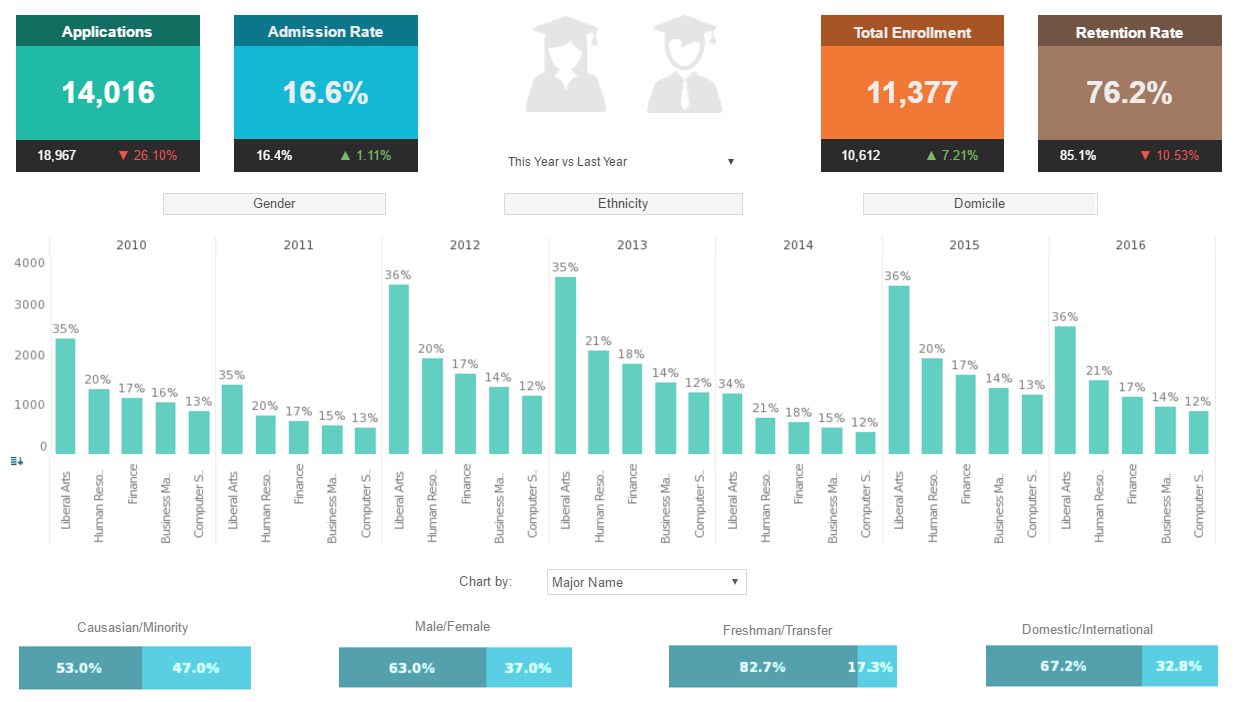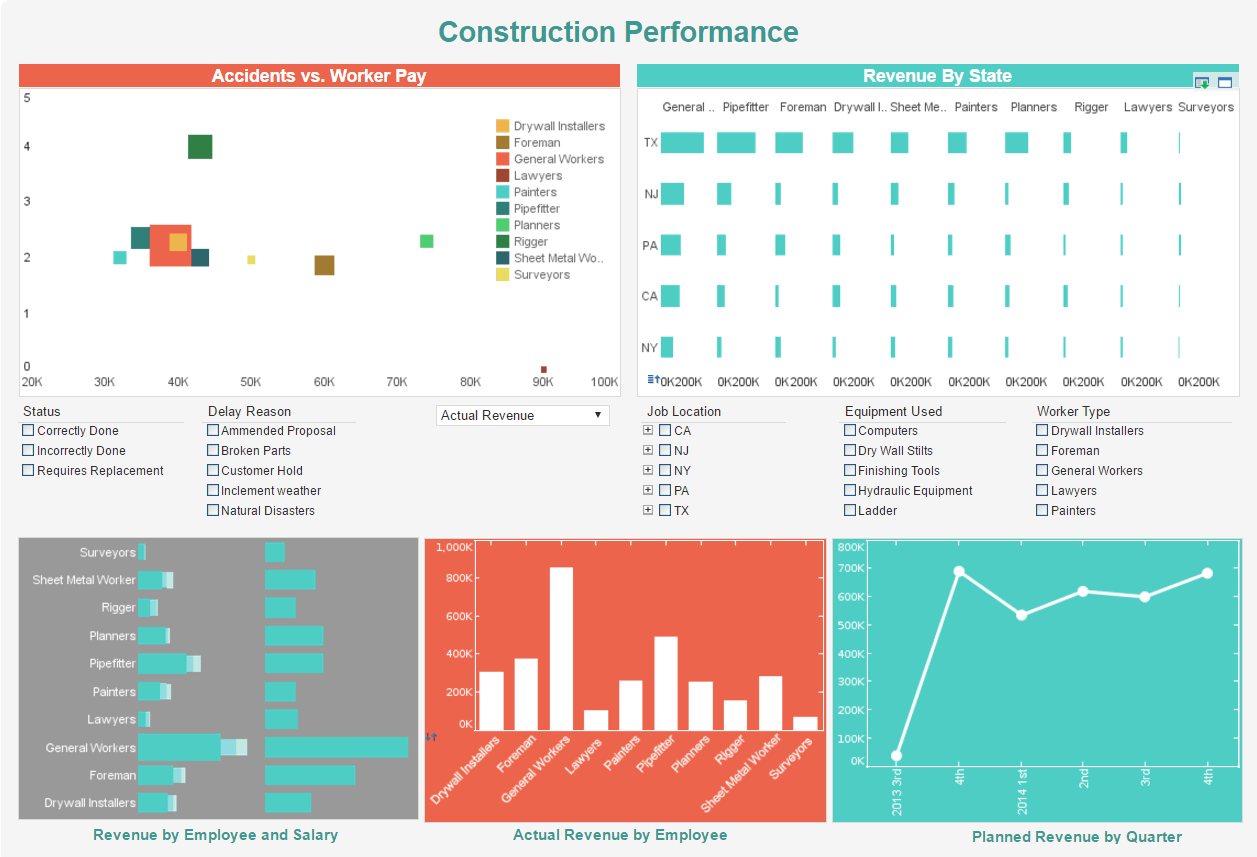InetSoft Offers a BI Platform Enabling End-Users to Do Their Own Data Mashup
Data mashup means combining disparate data sources that were not previously architected to be used together. In a data warehouse environment with rigid ETL process, data mashup yields other benefits, particularly in allowing prototyping of data manipulations before committing to new, official ETL definitions and transformations. Data mashup is a central capability of InetSoft's StyleBI business intelligence software. It's a platform focusing on operational BI with an intuitive user interface that accelerates usage of BI. Requirements as diverse as reporting, OLAP, scorecards, dashboards, visualization, and ad hoc analysis are all met in a unified application.



Key benefits include:
Exploring data with self-service solutions:- A visualization driven approach allows users to perform their own reporting and analysis with very little IT support. By using familiar graphical objects and an intuitive Web 2.0 interface end users are empowered to easily explore, manipulate, and display data to gain new insights.
- With its patent pending Data Block technology, InetSoft simplifies the process of accessing data. Users can retrieve information from data warehouses, transactional databases, or other sources regardless of whether they are stored as relational databases, XML, flat files, etc. This data can then be dynamically mashed-up, manipulated, and transformed as Lego like data assets.
- InetSoft has flexible pricing models that allow you to deploy a solution that accommodates your unique situation. InetSoft's architecture provides a total BI solution within one unified application. However, if your needs dictate, deploy just the components that you need.
- Built upon open J2EE standards our application provides a solution that incorporates clustering, load balancing, and failover to provide high availability and quick response time. Additional features such as page streaming, data caching, and performance tuning ensure optimal operation as your needs increase.
StyleBI from InetSoft. It's Easy. Agile. Robust.
| #1 Ranking: Read how InetSoft was rated #1 for user adoption in G2's user survey-based index | Read More |
What Data Sources Do Care Coordination Data Analysts Mash Up?
Care coordination data analysts rely on a variety of data sources to gain comprehensive insights into patient care, healthcare processes, and overall system efficiency. Mashup, in this context, refers to the integration and analysis of diverse datasets from multiple sources. Here are some key data sources that care coordination data analysts typically mash up:
- Electronic Health Records (EHRs):
- Patient medical history, diagnoses, medications, and treatment plans are crucial for understanding individual patient needs.
- Integration of EHR data provides a comprehensive view of a patient's healthcare journey across different care settings.
- Claims and Billing Data:
- Claims data from insurance providers contains information on medical procedures, services rendered, and associated costs.
- Analyzing billing data helps in understanding the financial aspects of healthcare services and optimizing reimbursement processes.
- Health Information Exchanges (HIEs):
- HIEs facilitate the sharing of patient information across different healthcare organizations.
- Data from HIEs enhances care coordination by providing a more complete picture of a patient's health status.
- Pharmacy Data:
- Medication data from pharmacies includes prescription details, adherence rates, and medication histories.
- Analyzing pharmacy data helps in medication reconciliation and ensures patient compliance.
- Laboratory Results:
- Integration of laboratory data provides insights into diagnostic test results, helping in monitoring patient health and treatment effectiveness.
- Abnormal results can trigger alerts for follow-up care coordination.
- Patient-Generated Health Data (PGHD):
- Wearables, mobile apps, and other patient-generated data sources provide real-time information on vital signs, activity levels, and lifestyle factors.
- Incorporating PGHD helps in remote monitoring and personalized care planning.
- Social Determinants of Health (SDOH) Data:
- SDOH data includes information about a patient's living conditions, socioeconomic status, and environmental factors.
- Analyzing SDOH helps in understanding the broader context affecting patient health and tailoring interventions accordingly.
- Care Plans and Care Management Data:
- Care plans outline the coordinated efforts of healthcare providers in managing a patient's health.
- Integrating care management data ensures alignment with established care plans and identifies areas for improvement.
- Population Health Data:
- Aggregated data on populations helps in identifying health trends, risk factors, and areas for targeted interventions.
- Population health data supports proactive care coordination strategies.
- Public Health Data:
- Data from public health agencies provides information on disease outbreaks, epidemiological trends, and community health indicators.
- Monitoring public health data enhances preparedness and coordination during health emergencies.
- Telehealth and Remote Monitoring Data:
- Data from telehealth visits and remote monitoring devices offer insights into virtual care interactions and patient health outside traditional healthcare settings.
- Integrating telehealth data supports the continuum of care and enhances patient engagement.
- Patient Satisfaction Surveys:
- Feedback from patient satisfaction surveys provides valuable insights into the patient experience and areas for improvement.
- Analyzing survey data helps in refining care coordination processes to meet patient expectations.
- Government Health Databases:
- Datasets from government health agencies provide information on public health initiatives, regulatory changes, and healthcare policies.
- Staying informed about government health data is crucial for compliance and adapting to evolving healthcare regulations.
- Clinical Research Data:
- Data from clinical trials and research studies contribute to evidence-based care coordination strategies.
- Incorporating research data helps in adopting the latest medical advancements and best practices.
More Resources About Data Mashup
Collaboration Through Building Blocks - Traditional collaboration, achieved through a mixture of business intelligence reports, desktop application files, emails, and other means, is the equivalent of collaborative document editing. The limitations of this approach become apparent as the number of parties involved grows. Moreover, collaborating parties cannot easily build upon each other's work. Wikipedia is a perfect ...
Evaluate InetSoft's Business Intelligence Software for SMEs - Are you a small or mid-sized firm looking for good business intelligence software? InetSoft, a pioneer in self-service dashboarding, gets high grades for personalized support. View a demo and try interactive examples...
How Do Hedge Funds Use Big Data? - Hedge funds have been at the forefront of using big data and advanced analytics to gain a competitive edge in the financial markets. The vast amount of data available today allows them to make more informed investment decisions, manage risk, and generate alpha (above-average returns). Here are several ways in which hedge funds leverage big data...
Why You Should Integrate Business Intelligence? - Increased operational efficiency is another advantage of BI integration. Data gathering, analysis, and reporting are just a few of the procedures that BI technologies may automate, freeing up personnel to work on more important projects. This may result in quicker reaction times, fewer mistakes, and increased productivity...
